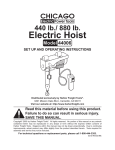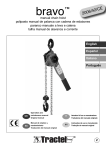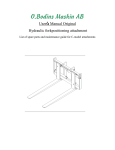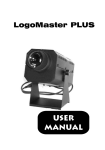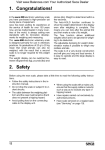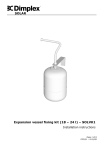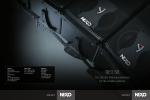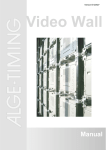Download User manual A4-3457 manrider block
Transcript
USER MANUAL MANRIDER BLOCK A4-3457 General description: This block is identified in the following way: • • • • Single sheaved block To be used as part of larger lifting appliances Møllerodden certificate number is stamped at the side of the block It is not to be regarded as lose gear Rules This block is designed to fulfill the requirements of the following rules and regulations: 1. 2. 3. 4. Machine directorate (FOR 2009-05-20 nr 544.) Regulations on safe use of equipment Regulations for Mobile Offshore Units. (NMD) Den Norske Skipskontrolls Regler. (NMD) Limitations in use: For safe use, the following shall be respected: 1. The block is to be used as specified. 2. The block shall not be overloaded. This means that the wire tension, wrap angle ant pull direction shall not exceed the approval. 3. Use only specified rope dimensions. 4. The block shall not be used for towing operations. 5. Skew loads onto the sheave shall be as small as possible and never exceed 2 deg. as standard. 6. The block is not designed for shock loads or side loads. 7. The block is to be used between temperatures of -20 deg. C to +80 deg C. Inspection To assure that the block may be used in a safe manner by the user, it needs regular inspection during continuous use and after some time out of use. The inspection shall be performed close to the block. Daily inspection shall as a minimum consist of the following: • • • • • Visual inspection for damage. Eventual damages shall be assed by a person with relevant competence to judge the severity of the damage up against the use of the block If the block is extensively dirty, it must be cleaned before the inspection is performed High pressure hosing with water is NOT allowed The bearings are to be checked for free movement as far as this is possible. Support structure shall be inspected and found satisfactory Yearly inspection shall be carried out by a competent company. They shall issue a condition report after the inspection. The user shall file these reports. Re-certifying This consists of dismantling the block by a competent company at the parts are to be checked with focus on wear, hidden damages and cracks. NDT shall be used and documented as requested by the competent person. Worn out parts shall be replaced and the block shall be re-assembled. The block shall be load tested again after this and re-inspected before a new certificate is issued. The most common points to inspect are: • • • • • • • Suspension. Wear of bolts, loose or missing bolts Hole for shaft in sideplates Play in bearings Sign of cracks in welds Sign of cracks in material Corrosion Condition of mounting structure Repair Damages detected during inspection shall be repaired as soon as possible. It shall be carried out by qualified personnel. • • • Parts that are to be replaced shall be supplied by Møllerodden AS or produced after procedures and requirements from Møllerodden. No form of welding is allowed on the block without written approval from Møllerodden obtained before the welding is started. The maximal wear allowed on any components is 5%. This also applies for holes. Maintenance The purpose of the maintenance is to prolong the lifetime of the block and maintain the safety of the block in use. The following points are to be focused: (See also the point Inspection.): 1. Lubrification. This is done through grease nipples located in center of shaft and in traverse. Greasing intervals and amount of grease is dependant of the use of the block and the environment in which it is sitting. As an indication of the time between lubrification, the following may be used: For blocks being used continuous: For blocks being used more infrequent: Greasing every 24 hour. Greasing every 14th day. The same applies for traverse and swivel bearing. Standard threads for greasenipples are M10x1. Other threads are being used on some blocks (1/4” UNF). Verify size, if other equipment is to be connected to the greasing points. Experience with the use of the block may yield other intervals. 2. If the block shall be dismantled or in other ways maintained, the load and the rope shall be removed. 3. The block has to be standing in a stable position before any work commence on it. If necessary it will have to be supported in a safe manner. Dangers Every use of lifting equipment or loose gear comes with a certain risk. To minimize or remove the risks when using such equipment consider the following points: • • • • • • • • • Use only certified undamaged equipment in lifting operations. Use the equipment only in the way it is designed. Errors during construction, production, wear from use or wrong use of equipment may result in an unwanted movement of load. This may result in damage to equipment or injuries to personnel, in worst case to death. Mounting and dismounting should be performed by personnel with sufficient technical background, both theoretical and practical. Personnel should not be located within the work area of the block or if the block is included in a system, within the systems work area. Do not touch the block or equipment that is in motion. Watch for loose clothing if personnel have to go close to the sheave. (Danger of hooking) When slacking off the rope, it is important to avoid the block falling or moving uncontrolled. Respect local rules / requirements for use of lifting equipment. Standard location of grease nipple.






